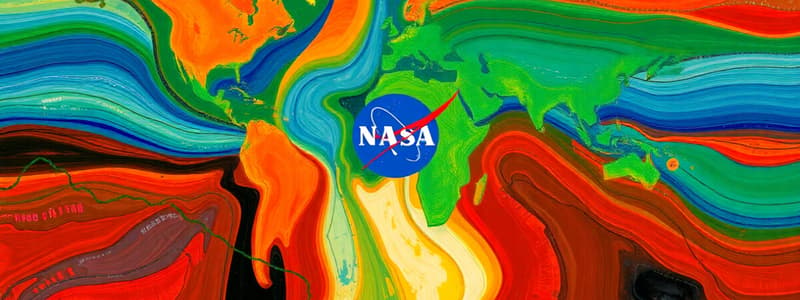Podcast
Questions and Answers
What does temperature anomaly indicate?
What does temperature anomaly indicate?
The 30-year period considered 'normal' for temperature anomalies is 1961-1990.
The 30-year period considered 'normal' for temperature anomalies is 1961-1990.
False
What time frame does the plotted data for average temperature anomalies cover?
What time frame does the plotted data for average temperature anomalies cover?
1880-2016
The line chart for January shows the average temperature anomaly in the __________ hemisphere.
The line chart for January shows the average temperature anomaly in the __________ hemisphere.
Signup and view all the answers
Match the following commands with their purpose:
Match the following commands with their purpose:
Signup and view all the answers
Which command is used to label the vertical axis for annual temperature anomalies?
Which command is used to label the vertical axis for annual temperature anomalies?
Signup and view all the answers
Annual average temperature anomalies were plotted with the same axis labels used for monthly averages.
Annual average temperature anomalies were plotted with the same axis labels used for monthly averages.
Signup and view all the answers
What significant concern is highlighted regarding climate change?
What significant concern is highlighted regarding climate change?
Signup and view all the answers
Which time period shows the highest mean summer temperature?
Which time period shows the highest mean summer temperature?
Signup and view all the answers
The standard deviation of summer temperatures decreased from the period 1951-1980 to 1981-2010.
The standard deviation of summer temperatures decreased from the period 1951-1980 to 1981-2010.
Signup and view all the answers
What command is used to create a data frame containing the mean and standard deviation of summer temperatures from the different periods?
What command is used to create a data frame containing the mean and standard deviation of summer temperatures from the different periods?
Signup and view all the answers
The standard deviation for the summer period 1921-1950 is ______.
The standard deviation for the summer period 1921-1950 is ______.
Signup and view all the answers
Match the following time periods with their corresponding summer temperature standard deviations:
Match the following time periods with their corresponding summer temperature standard deviations:
Signup and view all the answers
What is the default name of the temperature data file to be downloaded from NASA’s Goddard Institute for Space Studies?
What is the default name of the temperature data file to be downloaded from NASA’s Goddard Institute for Space Studies?
Signup and view all the answers
Temperature anomalies reflect absolute temperatures.
Temperature anomalies reflect absolute temperatures.
Signup and view all the answers
List one research question mentioned in the content.
List one research question mentioned in the content.
Signup and view all the answers
The government is concerned that climate change will result in more frequent __________ events.
The government is concerned that climate change will result in more frequent __________ events.
Signup and view all the answers
What do the columns labelled DJF, MAM, JJA, and SON represent in the dataset?
What do the columns labelled DJF, MAM, JJA, and SON represent in the dataset?
Signup and view all the answers
The temperature data can be imported into R using the command: tempdata = read.csv('NHTemp.csv',skip=1,na.strings = '***').
The temperature data can be imported into R using the command: tempdata = read.csv('NHTemp.csv',skip=1,na.strings = '***').
Signup and view all the answers
What causes the concern for more extreme weather events according to the content?
What causes the concern for more extreme weather events according to the content?
Signup and view all the answers
Match the seasons with their abbreviations:
Match the seasons with their abbreviations:
Signup and view all the answers
Which time period exhibited the highest mean summer temperature based on the analysis?
Which time period exhibited the highest mean summer temperature based on the analysis?
Signup and view all the answers
The standard deviation of summer temperatures increased from the period 1951-1980 to 1981-2010.
The standard deviation of summer temperatures increased from the period 1951-1980 to 1981-2010.
Signup and view all the answers
What is used as a measure of temperature variability according to the content?
What is used as a measure of temperature variability according to the content?
Signup and view all the answers
The government might need to invest more in mitigating the effects of __________ weather events.
The government might need to invest more in mitigating the effects of __________ weather events.
Signup and view all the answers
Match the time periods with their corresponding summer temperature standard deviations:
Match the time periods with their corresponding summer temperature standard deviations:
Signup and view all the answers
What is the normal period used for calculating temperature anomalies?
What is the normal period used for calculating temperature anomalies?
Signup and view all the answers
Temperature anomalies indicate temperatures that are lower than the average.
Temperature anomalies indicate temperatures that are lower than the average.
Signup and view all the answers
During which month does the provided command plot average temperature anomalies?
During which month does the provided command plot average temperature anomalies?
Signup and view all the answers
The term 'temperature anomalies' refers to how much warmer or colder the temperature is than normal for a particular place and time, typically compared to the average of __________.
The term 'temperature anomalies' refers to how much warmer or colder the temperature is than normal for a particular place and time, typically compared to the average of __________.
Signup and view all the answers
Match the following temperature anomaly periods with their expected trends:
Match the following temperature anomaly periods with their expected trends:
Signup and view all the answers
What color is used in the line chart to represent annual temperature anomalies?
What color is used in the line chart to represent annual temperature anomalies?
Signup and view all the answers
The average temperature anomaly in January is plotted against the year 1880.
The average temperature anomaly in January is plotted against the year 1880.
Signup and view all the answers
What significant concern is raised regarding climate change in the content?
What significant concern is raised regarding climate change in the content?
Signup and view all the answers
What is the main concern of the government regarding climate change?
What is the main concern of the government regarding climate change?
Signup and view all the answers
Temperature anomalies are measured as absolute temperature values.
Temperature anomalies are measured as absolute temperature values.
Signup and view all the answers
What is the default name of the temperature data file to be downloaded from NASA’s website?
What is the default name of the temperature data file to be downloaded from NASA’s website?
Signup and view all the answers
The research question addressing the occurrence of climate change is titled __________.
The research question addressing the occurrence of climate change is titled __________.
Signup and view all the answers
Match the seasons with their respective abbreviations:
Match the seasons with their respective abbreviations:
Signup and view all the answers
What command is used to read the temperature data into R?
What command is used to read the temperature data into R?
Signup and view all the answers
The columns labelled DJF, MAM, JJA, and SON in the dataset contain monthly data.
The columns labelled DJF, MAM, JJA, and SON in the dataset contain monthly data.
Signup and view all the answers
What methodology is suggested for investigating temperature distributions?
What methodology is suggested for investigating temperature distributions?
Signup and view all the answers
Study Notes
Data Analysis
-
Topic: Data analysis for climate change
-
Source: Michele Pezzoni
-
Purpose: Analyze temperature data to investigate climate change trends.
-
Research Questions:
- RQ1: Is climate change really happening?
- RQ2: Will weather become more extreme as a result of climate change?
-
Data Source Retrieval: Retrieve temperature data from NASA's Goddard Institute for Space Studies website (https://data.giss.nasa.gov/gistemp/).
-
Data Sources: Global and Hemispheric Monthly Means and Zonal Annual Means, including combined Land-Surface Air and Sea-Surface Water Temperature anomalies.
- Global-mean, monthly, seasonal, and annual means, 1880-present (TXT, CSV)
- Northern Hemisphere-mean data, 1880-present (TXT, CSV)
- Southern Hemisphere-mean data, 1880-present (TXT, CSV)
- Zonal annual means, 1880-present (TXT, CSV)
-
Data Import into R:
- Use the command
setwd("YOURFILEPATH")to set the working directory. - Use
tempdata = read.csv("NHTemp.csv", skip=1, na.strings = "***")to import the data set into R. (Alternatively, use the import data tool within RStudio). - Convert
tempdatato a data frametempdata=data.frame(tempdata). - Use the command
head(tempdata)andstr(tempdata)to check the format and content of the imported data.
- Use the command
-
Temperature Anomalies: Temperature data is measured as anomalies (deviations from the average).
- Normal temperature is the average over the 30-year period 1951-1980 for the particular location and time of year.
-
Plotting Temperature Data:
- Plot a line chart of average monthly temperature anomaly (e.g., January) from 1880-2016.
- Label axes with meaningful titles and include a suitable title for the chart.
- Incorporate a horizontal line representing the 1951-1980 average.
-
Plotting Annual Average Temperature Anomalies:
- Plot a line chart of annual average temperature anomalies from 1880-2016.
- Label axes with meaningful titles and include a suitable title for the chart.
- Incorporate a horizontal line representing the 1951-1980 average.
-
Plotting Summer Temperature Distribution:
- Create three new datasets for 1921-1950, 1951-1980, and 1981-2010.
- Plot histograms of the summer temperature (JJA) anomalies for each time period.
-
Quantiles:
- Use R's quantile function to find the 3rd and 7th deciles for the 1951-1980 period.
- Analyze the number of anomalies considered "hot" (above the 70th decile) for 1981-2010 period and calculate the percentage.
-
Standard Deviation:
- Assess temperature variability (e.g., summer) using the standard deviation for 1921-1950, 1951-1980, and 1981-2010.
- Compare standard deviations across different time periods to identify trends in temperature variability.
Conclusion
- Determine whether or not to recommend increased government spending to mitigate the effects of extreme weather events, based on the analyses.
Studying That Suits You
Use AI to generate personalized quizzes and flashcards to suit your learning preferences.
Related Documents
Description
This quiz focuses on analyzing temperature data related to climate change, inspired by the work of Michele Pezzoni. Participants will explore questions about the reality and extremity of climate change while working with data from NASA's Goddard Institute for Space Studies. It emphasizes practical skills in data retrieval and importing into R.




